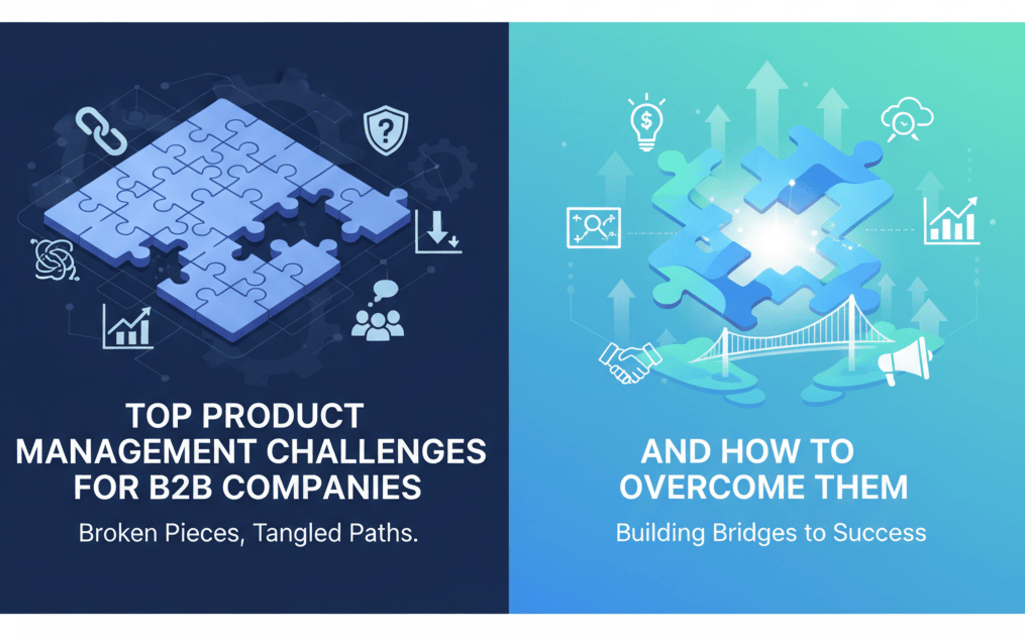
Top Product Management Challenges for B2B Companies and How to Overcome Them
Understanding the B2B Product Management Landscape
Product management in B2B environments presents unique challenges that differ significantly from consumer-focused businesses. Unlike B2C products where individual users make quick purchasing decisions, B2B product managers must navigate complex organizational structures, lengthy sales cycles, and multiple stakeholders with varying priorities.
The landscape has evolved dramatically, with expectations evolving and understanding your specialization becoming crucial for success. Modern B2B product managers face increasing pressure to demonstrate value while managing sophisticated customer relationships and enterprise-level requirements.
Challenge 1: Managing Complex Stakeholder Dynamics
In B2B environments, product managers often juggle multiple stakeholder groups, each with distinct needs and priorities. Sales teams push for features that help close deals faster, engineering teams focus on technical feasibility, and customers demand seamless integrations with their existing workflows.
The Problem: Decision-making becomes fragmented as stakeholders pull product development in different directions. A feature request from a high-value customer might conflict with your long-term product strategy, creating tension between short-term revenue needs and strategic vision.
Solution Strategies (with Product Siddha’s approach):
- Build a clear stakeholder communication framework with regular touchpoints and feedback loops
- Run a stakeholder mapping exercise to understand influence, authority, and competing priorities
- Design a transparent prioritization framework that balances customer input, business impact, strategic alignment, and development cost
- Use organized tools and templates (for instance, Product Siddha’s stakeholder management templates) to centralize and track requests, decisions, and dependencies
Example (based on our internal approach at Product Siddha):
One of our B2B SaaS clients was struggling with conflicting feature requests from multiple enterprise customers. Sales wanted customized modules to help close deals, while engineering warned of long technical debt, and senior leadership insisted on building foundational components. We introduced a weighted scoring model that considered customer lifetime value, strategic alignment, implementation effort, and impact on the core roadmap. After deploying this system, feature conflicts dropped significantly (by ~ 60%), prioritization became clearer across stakeholders, and the roadmap regained alignment with long-term vision.
By applying these solution strategies, you can reduce fragmented decision making, bring greater clarity to your roadmap, and ensure that every stakeholder’s input earns its place in a balanced, strategic process.
Challenge 2: Balancing Customer Feedback with Product Vision
B2B customers often have significant influence over product development, especially in enterprise deals. While customer feedback is valuable, over-reliance on individual customer requests can lead to feature bloat and a loss of product focus.
The Problem: Large enterprise customers may threaten to leave unless specific features are built, creating pressure to deviate from the core product strategy. This reactive approach can result in a fragmented product that serves no one well.
Solution Framework:
- Implement a customer feedback scoring system that evaluates requests based on market demand, not just individual customer pressure
- Create customer advisory boards to gather collective input rather than responding to isolated demands
- Develop clear criteria for when to accommodate custom requests versus when to maintain product standards
- Use data analytics to validate whether feature requests align with broader user behavior patterns
Challenge 3: Resource Allocation and Priority Management
91% of business leaders agree that their Product Information Management (PIM) system is invaluable, yet many B2B companies struggle with resource allocation across competing priorities. Limited development resources must be distributed among new features, technical debt, customer support, and strategic initiatives.
Resource Allocation Challenges:
| Challenge Area | Impact Level | Common Solutions |
|---|---|---|
| Technical Debt | High | Dedicated sprint allocation (20-30%) |
| Customer Escalations | Medium | Emergency fix protocols |
| New Feature Development | High | Roadmap prioritization frameworks |
| Integration Requirements | Medium | API-first development approach |
Strategic Approaches:
- Adopt capacity planning methodologies that account for both planned and unplanned work
- Create clear escalation criteria for customer issues that require immediate resource reallocation
- Implement portfolio management techniques to balance innovation with maintenance
- Use Product Siddha’s resource planning tools to visualize capacity constraints and make informed decisions
Challenge 4: Lengthy Sales Cycles and Product Validation
B2B sales cycles often span months or years, making it difficult to validate product decisions quickly. Unlike consumer products where user feedback is immediate, B2B product managers must wait extended periods to understand whether their strategic choices were correct.
Validation Strategies:
- Develop pilot programs with select customers to test features before full implementation
- Create prototype demonstrations that can be shared during the sales process
- Implement progressive disclosure techniques to gather feedback at multiple stages
- Use customer success metrics as leading indicators of product-market fit
Challenge 5: Integration Complexity and Technical Debt
B2B products rarely exist in isolation. They must integrate with existing enterprise systems, comply with security requirements, and support complex workflows. This integration complexity often leads to technical debt accumulation and increased development time.
Technical Management Solutions:
- Design API-first architectures that facilitate easier integrations
- Maintain comprehensive documentation for third-party developers
- Establish integration testing protocols that prevent regression issues
- Create modular product architectures that allow for flexible deployment options
Integration Best Practices:
- Standardize authentication and authorization protocols
- Provide webhooks and real-time data synchronization
- Support multiple data formats and export options
- Maintain backward compatibility across version updates
Challenge 6: Measuring Success in B2B Environments
Traditional consumer metrics like daily active users or page views don’t translate well to B2B products. Product managers must develop measurement frameworks that account for organizational usage patterns, multi-user scenarios, and business impact metrics.
B2B Success Metrics Framework:
Usage Metrics:
- Seats utilized per organization
- Feature adoption rates across user roles
- Integration depth and API usage
- Time to value for new implementations
Business Impact Metrics:
- Customer lifetime value improvement
- Renewal rates and expansion revenue
- Support ticket reduction
- Process efficiency gains
Challenge 7: Competitive Intelligence and Market Positioning
B2B markets often have fewer players but more sophisticated competition. Product managers must understand not just what competitors offer, but how they position themselves, their pricing strategies, and their customer acquisition approaches.
Competitive Analysis Framework:
- Regular competitor product teardowns and feature comparisons
- Sales team feedback collection on competitive encounters
- Customer win/loss analysis to understand decision factors
- Market positioning workshops to identify differentiation opportunities
Overcoming Implementation Challenges
Organizational Change Management: Successful product management transformation requires organizational buy-in. Companies must invest in proper training, establish clear communication protocols, and create cultures that support data-driven decision making.
Technology Infrastructure: Product teams need data-backed decisions, and tools like Productboard offer structured ways to bridge customer insights with product strategy. Investing in proper product management tools creates the foundation for effective decision-making and stakeholder communication.
Continuous Learning Culture: B2B product management requires continuous adaptation. Successful organizations create learning cultures where product managers can experiment, fail fast, and iterate based on market feedback.
Moving Forward with Confidence
The challenges facing B2B product managers are complex, but they’re not insurmountable. By implementing structured approaches to stakeholder management, customer feedback integration, and resource allocation, companies can build products that truly serve their market needs.
Success in B2B product management comes from balancing customer demands with strategic vision, maintaining technical excellence while delivering business value, and building organizational capabilities that support long-term growth.
Companies that address these challenges systematically, using proven frameworks and appropriate tools, position themselves for sustainable competitive advantage in their markets. The key lies in recognizing that product management is not just about building features – it’s about building sustainable business value through thoughtful product strategy and execution.
Looking for expert guidance on B2B product management challenges? Product Siddha provides comprehensive consulting services, training programs, and tools to help companies overcome these obstacles and build successful products. Visit Product Siddha to learn more about our proven methodologies and success stories.
